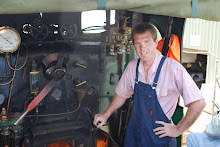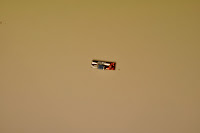Looking at them being plain and boring on the workbench got the better of me so I dragged out some old lining pens that I acquired from a deceased estate. I have a few of these now but have not been game enough to give it a go........They are the ones with the little reservoir and small tube. I had some old Humbrol red enamel lying around and proceeded to try a bit out on a scrap piece of styrene. I glued a strip of thin foam packaging glued to the back of a 15cm steel ruler.
I also made a curve template to the same curvature of the valence of the 38 so as I could end up with nice even curved lines. The same was done for the tender corners as well. I done all the corners and curves first. Some of these needed to be allowed to dry before the next nearest curve could be done as the template sat atop the wet painted lines. Once all the corners and curves were allowed to dry I joined all them up with the straight lines with the steel rule. I only done one of the two 38's. The other was a streamlined version......I chickened out with this one as I did not want to tackle the whiskers.
Definitely not a Ted Flowers job, But certainly passable. The old 38 sold for $330 on EBay. The unlined one sold for about $220.
Another project I have started, for another friend, is to paint two Classic Brass 32's. The job also entails fitting Tsunami sound decoders to both locos. The two were both completely stripped and soaked in thinners to remove all traces of clear coat. All parts were then treated to a dip in the caustic soda to remove all traces of oil etc. They were then given a coat of paint (everywhere) with my etch black.
The Tsunami decoders give the ability to add some great lighting affects to our models. Wanting something a little different I thought I would try and include a firebox light both under the loco and inside the firebox along with working marker lights, headlight and cab light. The classic 32 has a removable back head casting that has a hole in the casting for the fire hole door. There is also room for mounting a LED and resistor behind the door. I made up several light boards using PCB ties from Clover House. I ran a razor saw down the middle of a short piece and also across one of the two tracks. The Surface mount LED can be carefully soldered to the end of the board and 1K surface mount resister on either side of the cut in the track. The LED came with leads attached. Before removing the leads I determined the polarity of the LED before removing the wires and mounting to the board.I also added a little Tamiya Clear red so give a little extra orange glow.
One of these will be mounted under the loco between the back set of driving wheels. The other I mounted on the back of the back head using double sided tape so as the LED will shine through the fire hole.
For the cab light I decided to use an incandescent globe. These cab lights were not real good at the best of times and I did not want to really 'light up' the cab, just add a little extra glow. A trial and error test was done using different size resistors. This resistor for the cab light was mounted on the side of the back head casting under the drivers seat. You can see the cab light sticking up above the back head.
For the front marker lights, I drilled out using a 1mm drill all the front markers for both locos before they were painted. I purchased from DCC Concepts some of their nano LED's. They say you can fit two of these in a 1mm hole. I have not yet fitted these but will see how they go. They are incredibly small.
I was not going to add rear markers to the tender........But will see how the rest turns out. I might be over it all by then!
Both the cab light and front markers will be wired to the function 5 output of the decoder and will I function map this to operate using function 1. (do away with the bell). The fire box lighting will be wired to the function 6 output and programmed with fire box flicker and mapped to button 4. If I install rear markers to the tender, I will use a bi colour tower LED (clear/red). This allows red for forward operation and clear for reverse. I don't think this is prototypical, but looks great. From memory, when the clear side of the LED is powered the same time as the red, the red overpowers the clear, producing a red light. So when you unpower the red side of the LED it will turn clear. So, when wiring these up I will power the clear side (reverse) with the front marker wire. They will be on all the time. Then power the Red with the rear loco light wire mapped to operate when in forward. The red markers will be on in forward and clear in reverse.........If that all makes sense!
I hope to produce a night photo with all the lights on.......Stayed tuned.
One other feature I have been doing is installing Cam operated chuff's......to all the steamers now. I have been using the soundtraxx cam kits. These are great. They are basically a thin circuit board with four segments,4 chuff's per revolution, mounted to the back of a driving wheel. The only problem with these cam kits is that you are only able to use a few of the cam wheels. The others are suitable for geared or articulated locos. ssssshhhhh but AndIan models are looking at making NSW specific ones!
Once mounted on the back of the driver a small wire pickup runs against the cam board and wired to the Tan decoder wire on the 1000 series decoder and brown on the 750's. Oh, you will need to earth out the cam wheel to the wheel itself. I always mount mine on the non insulated side of the loco. I use electrical conductive paint (Jacar) to earth it to both the axle and wheel dread. It will produce a perfect 4 chuff's every time regardless of the speed. Try them out, they are great. Here is one mounted to the rear driver of the 32. I have not yet added the pickup wire.
That enough for now.
C ya.
Ian









No comments:
Post a Comment